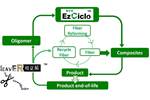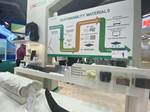Swancor introduces eco-friendly epoxy hardener for PCB recyclability
Through the use of EzCiclio low-dielectric epoxy hardener, PCB manufactures can make recyclable, reusable products for electronic applications.
Swancor’s announced its novel epoxy hardener at the International Taipei Taiwan Printed Circuit Association Show (TPCA) 2023. Photo credit, all images: Swancor
’s (Nantou, Taiwan) R&D team introduces EzCiclo low-dielectric epoxy hardener tailored for copper-clad laminates (CCL), enabling the use of recycled waste plastics in printed circuit board (PCB) production. The company employs a chemical process to prepare active ester oligomers from waste plastics, which serve as these epoxy resin hardeners.
PCBs are made of non-conductive laminates (dielectric) and conductive metal films. The board substrate, or core, is commonly epoxy resin and fiberglass (ceramics can be supplemented to increase the dielectric constant). Copper foils sandwiches this core on one or both sides (the CCL), creating an outer protective layer.
Recycled resin product characteristics (top table) and test results of the recycling resin formula (bottom table).
According to Swancor, waste PCBs are an increasingly serious problem. Since they are at the heart of most electronic devices, from smartphones to medical equipment, ensuring the PCB also complies with SDG initiatives is critical to comprehensive recycling efforts.
The EzCiclo low-dielectric epoxy hardener for PCBs uses more than 80% of waste plastic materials while retaining the properties of traditional hardeners. This solution enhances the electrical properties of epoxy resin FR4 boards, achieving Dk-2.78/Df-0.011 at 10 GHz after pure resin curing. Additionally, it increases the recyclable material content of PCBs, aligning with waste reduction and carbon reduction goals. At the end of the PCB’s life, the CCL made from Swancor’s EzCiclo can be decomposed by using the Swancor CleaVER chemical treatment, allowing the separation of the resin and glass fiber from the circuit board. It can be applied to any product that uses a PCB, including general electronic products, in-vehicle or network communications.
CCL made from EzCiclo low-dielectric epoxy hardener (left) and a copper toil after degradation via Swancor’s CleaVER liquid (right).
Through collaboration with the Industrial Technology Research Institute (ITRI) in Taiwan, Swancor has developed formulations and conducted laminate tests, finding that the copper foil substrates comply with IPC specifications such as IPC-4101E/21, IPC-4101/122 and IPC-4101/125.
Related Content
-
Plant tour: Sekisui Aerospace, Orange City, Iowa, Renton and Sumner, Wash., U.S.
Veteran composites sites use kaizen and innovation culture to expand thermoplastic serial production, 4.0 digitization and new technology for diversified new markets.
-
Thermoplastic composites: Cracking the horizontal body panel nut
Versatile sandwich panel technology solves decades-long exterior automotive challenge.
-
From the CW Archives: Airbus A400M cargo door
The inaugural CW From the Archives revisits Sara Black’s 2007 story on out-of-autoclave infusion used to fabricate the massive composite upper cargo door for the Airbus A400M military airlifter.






